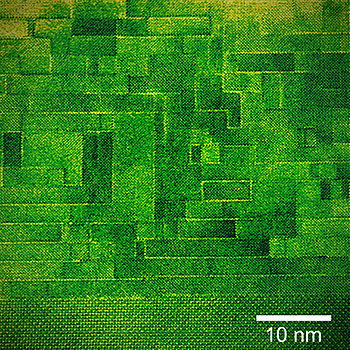Crystal radio: the solution to next-gen comms?
A new type of self-correcting crystal works up to 100 GHz, opening the door for a new generation of devices for advanced communications.
Researchers from the US National Institute of Standards and Technology (NIST) have joined with an international team to engineer and measure a potentially important new class of nanostructured materials for microwave and advanced communication devices. Based on NIST’s measurements, the new materials - a family of multilayered crystalline sandwiches - might enable a whole new class of compact, high-performance, high-efficiency components for devices such as mobile phones.
“These materials are an excellent example of what the Materials Genome Initiative refers to as ‘materials-by-design’,” says NIST physicist James Booth, one of the lead researchers. “Materials science is getting better and better at engineering complex structures at an atomic scale to create materials with previously unheard-of properties.”
The new multilayer crystals are so-called ‘tunable dielectrics’, the heart of electronic devices that, for example, enable mobile phones to tune to a precise frequency, picking a unique signal out of the welter of possible ones.
Tunable dielectrics that work well in the microwave range and beyond - modern communications applications typically use frequencies around a few gigahertz - have been hard to make, according to NIST materials scientist Nathan Orloff. “People have created tunable microwave dielectrics for decades, but they’ve always used up way too much power.” These new materials work well up to 100 GHz, opening the door for the next generation of devices for advanced communications.
Modern mobile phone dielectrics use materials that suffer from misplaced or missing atoms called ‘defects’ within their crystal structure, which interfere with the dielectric properties and lead to power loss. One major feature of the new materials, says Orloff, is that they self-correct, reducing the effect of defects in the part of the crystal where it counts. “We refer to this material as having ‘perfect faults’,” he says. “When it’s being grown, one portion accommodates defects without affecting the good parts of the crystal. It’s able to correct itself and create perfect dielectric bricks that result in the rare combination of high tuning and low loss.”

The new material has layers of strontium oxide, believed to be responsible for the self-correcting feature, separating a variable number of layers of strontium titanate. Strontium titanate on its own is normally a pretty stable dielectric - not really tunable at all, but another bit of nanostructure wizardry solves that. The sandwich layers are grown as a thin crystalline film on top of a substrate material with a mismatched crystal spacing that produces strain within the strontium titanate structure that makes it a less stable dielectric - but one that can be tuned. “It’s like putting a queen-sized sheet on a king-sized bed,” says Orloff. “The combination of strain with defect control leads to the unique electronic properties.”
One key discovery by the research team was that, in addition to adding strain to the crystal sandwich, adding additional layers of strontium titanate in between the strontium oxide layers increased the room-temperature ‘tunability’ performance of the structure, providing a new mechanism to control the material response. The material they reported on recently in the journal Nature has six layers of strontium titanate between each strontium oxide layer.
The new sandwich material performs so well as a tunable dielectric, over such a broad range of frequencies, that the NIST team led by Booth had to develop a new measurement technique - an array of test structures fabricated on top of the test film - just to measure its electronic characteristics. “We were able to characterise the performance of these materials as a function of frequency running from 10 hertz all the way up to 125 gigahertz. That’s the equivalent of measuring wavelengths from kilometres down to microns all with the same experimental set-up,” says Orloff. He added, “This material has a much lower loss and a much higher tunability for a given applied field than any material that we have seen.”
An international team of researchers contributed to the recent paper, representing, in addition to NIST, Cornell University, the University of Maryland, Pennsylvania State University, the Institute of Physics ASCR (Czech Republic), Universitat Politècnica de Catalunya (Spain), the Kavli Institute at Cornell for Nanoscale Science, Oak Ridge National Laboratory, the Leibniz Institute for Crystal Growth (Germany), The University of Texas at Austin and Temple University.
2025–26 Thought Leaders: Tim Karamitos
Tim Karamitos from Ericsson discusses the connectivity requirements of emergency services and...
2025–26 Thought Leaders: Ruth Tovo
Comms Connect panellist Ruth Tovo, from the South Australian SES, discusses the technical...
ARCIA update: celebrating excellence in our industry
The ARCIA Annual Gala Dinner and Excellence Awards took place during the same week as Comms...



